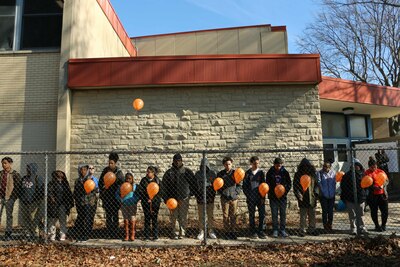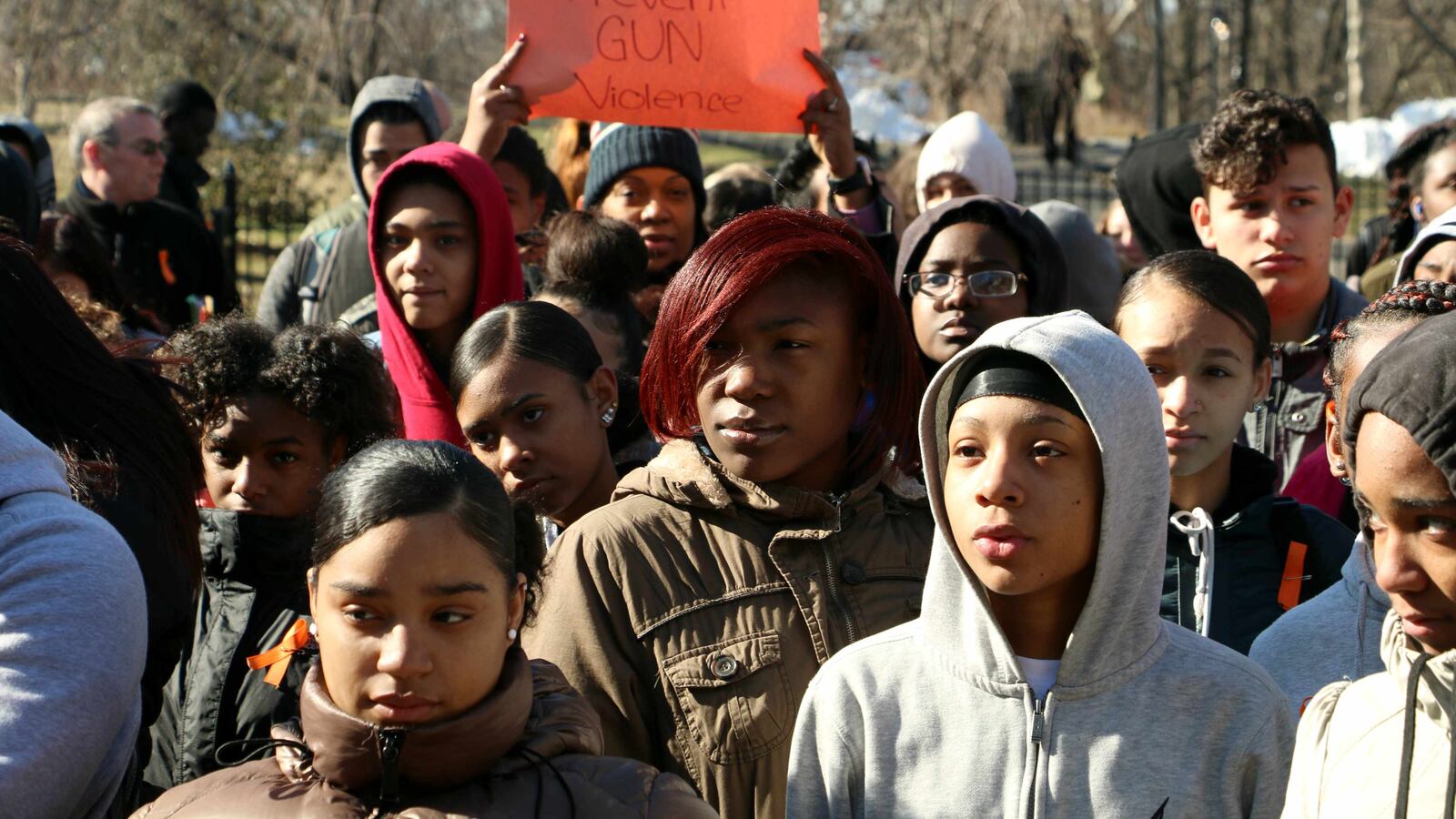Thousands of Newark students walked out of their schools Wednesday morning in a district-sanctioned protest that was part of a nationwide action calling for an end to gun violence.
At Barringer Academy of the Arts and Humanities in the North Ward, students gathered in the schoolyard alongside Mayor Ras Baraka and interim schools chief Robert Gregory, who offered support to the protesters and even distributed a “student protest week” curriculum to schools.
Just after 10 a.m., hundreds of students watched in silence as a group of their classmates stood in a row and released one orange balloon every minute for 17 minutes — a tribute to the 17 people fatally shot inside a high school in Parkland, Florida last month.
While the Barringer students and faculty mourned those victims they had never met, they also decried gun violence much closer to home: siblings and relatives who had been shot, times they were threatened with guns on the street. Principal Kimberly Honnick asked the crowd to remember Malik Bullock, who was a 16-year-old junior at Barringer when he was shot to death in the South Ward last April.
“Too many lives have been lost way too soon,” she said. “It is time for us to end the violence in our schools.”
School districts across the country have grappled with how to respond to walkouts, which were scheduled to occur at 10 a.m. in hundreds of schools. The student-led action, which was planned in the wake of the Florida mass shooting, is intended to pressure Congress to enact stricter gun laws.
Officials in some districts — including some in New Jersey — reportedly threatened to punish students who joined in the protest. But in Newark, officials embraced the event as a civics lesson for students and a necessary reminder to lawmakers that gun violence is not limited to headline-grabbing tragedies like the one in Parkland — for young people in many cities, it’s a fact of life.
“If there’s any group of people that should be opposed to the amount of guns that reach into our communities, it’s us,” Baraka said, adding that Newark police take over 500 guns off the street each year. “People in cities like Newark, New Jersey — cities that are predominantly filled with black and brown individuals who become victims of gun violence.”
On Friday, Gregory sent families a letter saying that the district was committed to keeping students safe in the wake of the Florida shooting. All school staff will receive training in the coming weeks on topics including “active shooter drills” and evacuation procedures, the letter said.
But the note also said the district wanted to support “students’ right to make their voices heard on this important issue.” Schools were sent a curriculum for this week with suggested lessons on youth activism and the gun-control debate. While students were free to opt out of Wednesday’s protests, high schools were expected to allow students to walk out of their buildings at the designated time while middle schools were encouraged to organize indoor events.
In an interview, Gregory said gun violence in Newark is not confined to mass shootings: At least one student here is killed in a shooting each year, he said — though there have not been any so far this year. Rather than accept such violence as inevitable, Gregory said schools should teach students that they have the power to collectively push for changes — even if that means letting them walk out of class.
“Instead of trying of trying to resist it, we wanted to encourage it,” he said. “That’s what makes America what it is.”

After Barringer’s protest, where people waved signs saying “Love,” “Enough,” and “No to gun violence, several ninth-graders described what it’s like to live in communities where guns are prevalent — despite New Jersey’s tight gun restrictions.
Jason Inoa said he was held up by someone claiming to have a gun as he walked home. Destiny Muñoz said her older brother was shot by a police officer while a cousin was recently gunned down in Florida. The Parkland massacre only compounded her fear that nowhere is safe.
“With school shootings, you feel terrified,” she said. “You feel the same way you do about being outside in the streets.”
Even as the students called for tougher gun laws, they were ambivalent about bringing more police into their schools and neighborhoods. They noted that the Black Lives Matter movement, which they said they recently read about in their freshmen social studies class, called attention to black and Hispanic people who were treated harshly or even killed by police officers.
Ninth-grader Malik Bolding said it’s important to honor the victims of school shootings like the one in Parkland, Florida. But the country should also mourn the people who are killed in everyday gun violence and heed the protesters who are calling for it to end, he added.
“Gun violence is gun violence — it doesn’t matter who got shot,” he said. “Everybody should be heard.”

